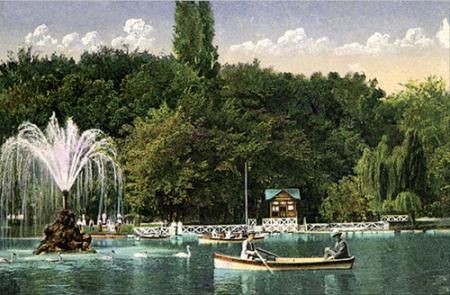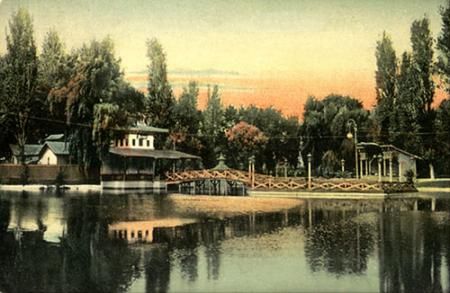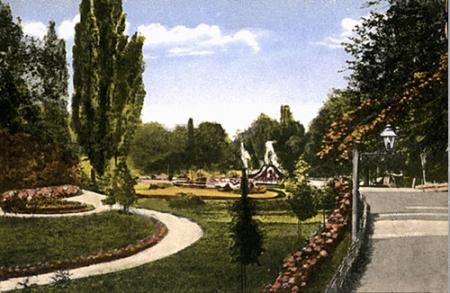The most popular public garden of Bucharest - and also it's oldest - it is a beautiful and large park in the heart of the city, well known to all those who live in Romania's capital. While not the largest public garden, it has a special charm and atmosphere, due do the fact that it's history begins in the 18th century, and since than little has been changed in the original plans. It is one of those symbolic places in Bucharest, which still brings to life the fascination and identity of the old city.

The story of the Cismigiu Garden begins in the 18th century. With it's unusual name, as surely most of those who visit it do not know from where it comes. In 1779 Alexandru Ipsilanti, then the ruler of the province, decided to build two fountains, for that the locals have fresh water. One was built on the spot of today's entry to the park and near this was the house of Dumitru suiulgi-basa. He would direct the construction, and gained the title of "Marele Cismigiu", from the Turkish term for public fountain. Hence the unusual name that the public garden would later have. Till the beginning of the next century the garden's name of Dura the Merchant's Garden. It was much larger and wilder, with an unatended lake and wild geeze all around. It was only in 1830 that General Pavel Kiseleff ordered Borroczyn to plan a large public garden on the same spot. This project was undertaken only during the reign of Gheorghe Bibescu, by the Vieniese landscape architect Friederich Wilhelm Meyer. The pond became a beautiful lake, with a sewer system which allowed it to be emptied and cleaned. In winter time it became a skating place, very popular from the very start. Meyer also planned to alleys and managed the planting of over 30.000 different trees, both foreign and local, as well as flowers, small bridges, benches and so on. It was a great success and in a short while Meyer was a celebrity, being invited at parties and official happenings, among the moist ilustrious and respected families. Sadly, he died at just 38, while he was enjoying his glory days. But the Cismigiu Garden remained.

In the past the garden was much larger and more interesting than we see today. It even had a small zoo, with bears, wolves, foxes, beavers, swans and exotic fish. There were several rules that had to be observed in Cismigiu : no one could enter on horse or in a carriage ; no dogs or other animals were alowed ; you had to pay a fine for stepping on the grass or on the flowers ; you had to restrain yourself from making too much noise ; you could enter the park from dawn till 10 o'clock in the evening, even longer during the summer. Everyone respected these simple rules - some still in effect today - and the fame of the park grew rapidly.
The Cismigiu Garden was finished and officially opened in 1854, with it's graceful and carefully though plan, with wornderful flowers, bushed, trees, benches, pavilions, animals and alleys. Those who loved music could attend for free the concerts of military and folk bands. Also, several shows were held here, mainly cultural manifestations, many for charity. In a short time artists from all over, mainly portraitist and landscape artists began working here, often selling their works to visitors, for a small fee. You could buy oranges and lemons, sodas, sweets and other delicacies, sold at special vending points, often by ladies from rich families. It wasn's something very fashionable to do this.

Especially during spring and summer, the Cismigiu Garden was filled with visitors, of all ages, and many of these came for the interesting shows put together by musicians, artists and even circus performers from all over the world. In 1889, for example, a certain Leona Dare, a French acrobat, impressed the public with her audacious stunts. Also, during the summer you could swim in the lake of take a boat ride. In winter time it was the season for skating, as the lake was covered with thick, great ice. In the last decade of the 19th century at the main entrance in the park, across from the City Hall, the first news-stand was opened, one of the very first in Bucharest, still existing today.
Today we can also see in Bucharest a restaurant with a terrace overlooking the lake. While it may seem a new place, the restaurant was actually built before the Second World War by the famous architect Ion Mincu. It was named Monte Carlo and offered a great selection of national Romanian specialities. Bombed and destroyed in the war, was reconstructed later, pretty much following the original plans.
Also of great interest in the park is the selection of statued, displayed in the Roman Rotonde. Opened in 1943, this part of the Cismigiu Garden has the busts of important writers in Romanian history, from Eminescu to Maiorescu, Caragiale, Cosbuc, Creanga, to Alecsandri, Hasdeu and others. When it comes to statues, Cismigiu has several impressive old works of art, scattered all around - the statue of Mother Smara, that of George Panu, the Sissi Stefanidi Spring, Eminescu's Spring, everyone of these having it's story and legends.
2008-02-21

































